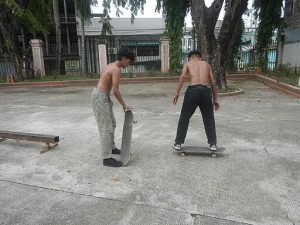Welcome, skateboarding enthusiasts! Are you ready to build a skateboarding grind rail at home?

We understand that hitting the hardware store for skate equipment isn’t always an option – maybe it’s too far away, or perhaps you would rather practice privately before showing off your skateboard skills. Whatever your reason may be, we’ve got you covered. We’ll provide you with a step-by-step guide and materials from your local hardware store to build a skate. You’ll have a durable, safe grind rail that can be used right at home, and we’ll ensure it’s inches wide for optimal use.
From gathering flat bar materials and instructions for assembly to safety precautions – we’ll guide you step by step. Plus, after this project, we have even more DIY projects lined up for you.
The good news is that, making your own grind rail or ramp can be easy with our guide. So let’s tap into our inner craftsman and craftswoman and get started on making our homes the ultimate skate destination!
Key Takeaways
- Necessary skateboarding materials and equipment include wood, screws, bolts, and fasteners. Recycling options can be explored to reduce costs and waste.
- Designing and assembling a skateboarding grind rail at home allows for customization with materials like aluminum, steel, wood, or plastic to match personal style and performance needs.
- Step-by-step assembly instructions for skateboard railings are provided, prioritizing safety and quality materials while being budget-friendly.
- Safety precautions during at-home skateboard rail assembly include wearing protective gear and ensuring a clean, well-lit environment.
- Tips for using the new skateboarding rail emphasize practicing safe skating, using quality skate parts, and staying alert while skateboarding.
- Maintaining the skateboarding rail is essential for smooth skate rides and a prolonged lifespan. Regular inspection, rust prevention, and quick cleaning are recommended.
Materials
Before you can start crafting your DIY skateboard grind rail at home, you’ll need to assemble some essential materials and equipment from your local hardware store. This includes wood, screws, bolts, fasteners, and a wide selection of other essentials. Build your grind rail by exploring material recycling options to keep costs down while reducing waste. You can find various guides and games online to help you through the process.
Always check the top features of the newest ramp design, including a railing with adjustable height, secured by long screws, to help skaters learn and perform tricks safely.
Additionally, conducting a cost analysis of all the materials and equipment needed will ensure you’re prepared for any unexpected expenses. FamilyHype encourages readers to share their feedback about the content, their experiences, or opinions. With the desired long length of flat bar, steel pieces, and all the materials from the hardware store sorted out, you can now dive into the fascinating process of designing your rail to grind on.

Designing Your Rail
Ready to craft your rad setup for tricks and flips? Designing railings isn’t just about function, it’s also about aesthetics. Here at FamilyHype, we understand that when it comes to riding skateboards, it’s all about personal style. Think carefully about how you want the rail, whether flat or round, wood or steel, to look and feel.
Customization options are endless – choose materials like aluminum, wood and steel, wood, or plastic that suit your style and performance needs. With the rail design, you can truly express yourself and create a unique grind rail that reflects your style. The length of your nail should also be correct. Once you’ve nailed your design with the desired length, flat bar, and steel pieces, we can help you piece together all the elements into one gnarly rail! Let us know how we can help you create the perfect rail for your tricks and flips.
Assembly Instructions
Now, let’s dive into the nitty-gritty of piecing together your custom grind rail as if you’re assembling a jigsaw puzzle with an adrenaline rush. DIY skate enthusiasts will find rail customization not just fun but also budget-friendly!
Just like you see when people advertise their product, design the rail of good size. Once you add a couple of unique features and drill holes for your custom sign.
Here at FamilyHype, we prioritize safety and quality materials while ensuring a cost-effective approach to custom skateboard assembly. Start by joining the base and supports, then attach the grind rail. Make sure the square rail is perpendicular to the feet and then secure it using screws and bolts. Ensure everything is snug and level.
Safety Precautions
As you embark on the journey of building your custom rail, here at FamilyHype, we encourage you to prioritize safety above all else. Always wear protective gear during assembly – gloves, safety glasses, and a helmet are a must. Make sure the assembly environment is clean, well-lit, and free from distractions. These precautionary measures will keep you safe while creating your dream rail.
Once you have your safety gear on and your assembly environment is in order, it’s time to get the most out of your new skateboard rail! It is an exhilarating activity for all ages and skill levels, and it’s important to take the necessary safety precautions when constructing a rail. To ensure a safe building experience, make sure to equip yourself with the right parts such as trucks, wheels, grip tape, and hardware. Additionally, consider the deck size, shape, and material to best fit your personal style and skill level. With the right pieces, inches wide, you can ensure that your rail is built to last and safely enjoy it for years to come.

Using Your New Rail
Now that we’ve built our skateboard rail and discussed safety during assembly, let’s shift gears and talk about using your new rail effectively. We’ll dive into some key tips for practicing safe skating to ensure both you and your rail stay in top shape. Plus, we’re going to share advice on maintaining your rail so it can deliver long-lasting performance for all your tricks and fun.
Skateboard Safety
When practicing those awesome skateboard tricks on your new two-foot skate grind rail or two-piece square rail, it’s essential to prioritize safety. Here at FamilyHype, we believe that skating is a great way to have fun and express yourself, but it’s also important to wear the necessary protective clothing and helmet to ensure you stay safe.
Even when taking all the necessary precautions, accidents can still happen, so be sure to stay alert and aware of your surroundings. Riding a skateboard is a great way to stay active, and it’s important to practice safety so we can continue to enjoy it for years to come. Now, let’s focus on how to keep your rail in top condition. To get the most out of your round rail, make sure to use quality skateboard wheels and trucks, as well as durable materials such as wood and steel or aluminum.
Additionally, it’s important to keep your skate grind rail’s diameter consistent and legs stable and to regularly check for any potential issues. With these tips, you can ensure you have a safe and enjoyable skating experience. Whether you prefer a one-piece skate grind rail or a round rail, proper maintenance and safety measures will keep your rail performing at its best. Happy skating!
Maintaining Your Rail
Maintaining your one-piece rail not only ensures smooth and exhilarating rides but is also a labor of love. At FamilyHype, we believe that caring is vital to preserving the thrill of riding skateboards. To help make a rail and maintain its longevity, we recommend inspecting it regularly for damage, drilling it with precision, applying rust prevention measures, cleaning off dirt and debris quickly, and repairing any issues as soon as they arise.
When we take the time to practice good maintenance and embark on a DIY project to make a rail, we not only look out for our fellow skaters but also keep our passion for it alive.

Other Skateboarding Projects
Once you’ve honed your rail construction skills, there are countless DIY projects for you to explore. From creating DIY decks to constructing at-home skateparks, your enthusiasm can help transform any street corner into a playground for fellow skaters. With the right tools and a generous spirit, the possibilities of DIY skateboard rail construction, with a tube on top for that perfect skateboard grind, and other projects are endless.
Incorporating steel grind elements ensures durability, while the process of legs making contributes to stability and strength. We hope this content provides an opportunity for you to further your knowledge and skills and enjoy the countless benefits of DIY projects.
Conclusion
We’ve shown you how to build your skate rail at home, and with the help of FamilyHype, we hope you’ve enjoyed this fun, hands-on project. It not only enhances your skating experience but also adds a personal touch to your training. Riding a skateboard is an exciting sport that requires precision, skill, and creativity. You can now hone all of these skills with your DIY rail. Always remember to prioritize safety during assembly and usage.
With this new skill, we’re sure you’ll be inspired to take on more DIY projects. You can try building custom ramps, constructing mini ramps, and creating grind boxes. We would love to hear your feedback about your experience and any other DIY skateboard projects you take on. Whether you’re planning to build a skate or modify an existing one to be inches wide, let’s keep the DIY spirit alive and enjoy your grind!
Frequently Asked Questions
How Do You Build A Wooden Skateboarding Rail?
To build a wooden rail, you’ll need the following materials: pine base plank, plywood planks, pine middle plank, and pine top plank. First, cut the plywood to your desired length and attach it to the pine base plank as the support structure. Then, secure the pine middle plank perpendicular to the plywood, acting as the main rail. Finally, attach the pine top plank above the pine middle plank to complete the grind rail.
How Do You Build A Rail Without Welding?
To construct a skate rail without welding, you can use wood and steel pieces. Follow a similar process as mentioned earlier for the wooden rail but replace the steel grind rail with a steel pipe. This steel pipe can be connected to the wooden structure securely using bolts, brackets, or clamps.
How To Make A PVC Pipe Rail?
Creating PVC pipe skate rails is a straightforward process. You’ll need a steel tube as the base and a PVC pipe as the rails. Attach the PVC pipe to the steel tube using fittings or adhesives. Ensure the PVC pipe is securely fixed on top of the steel tube so that it can withstand tricks and movements.
How Do You Rail A Skateboard?
When referring to “railing a skateboard,” it usually means executing a grind or slide trick on rails or ledges using the trucks or underside. Skaters can perform various rail tricks by sliding the metal trucks along the rail’s surface while balancing on the deck.
How Do You Make A Skateboard Rack?
You’ll need square tubing or wood pieces. Cut the square tubing or wood to the desired length, allowing ample space to hang multiple skateboards side by side. Attach the pieces vertically on a sturdy base, ensuring they are evenly spaced to hold them securely.
Can You Weld Without Using Electricity?
No, traditional welding techniques require electricity to generate the heat necessary for fusing metal pieces. Welding machines use electrical current to create an arc or resistance that generates extreme heat, melting the metal parts and allowing them to bond.
Can You Weld Without Using Rods?
No, welding typically involves the use of welding rods or filler metals to facilitate the joining process. These rods are melted along with the base metal during the welding process, forming a strong and continuous bond between the materials being welded.
What Materials Cannot Be Welded?
Some materials are challenging to weld, while others cannot be welded at all due to their composition or properties. For instance, materials with low melting points, such as certain plastics, cannot undergo traditional welding processes. Additionally, materials with high reactivity, like some types of glass or ceramics, may not be suitable for conventional welding.
How Bendy And Flexible Is PVC Pipe?
The flexibility of PVC pipe can vary depending on its diameter and thickness. Generally, PVC pipes are relatively bendy, especially compared to rigid materials like metal pipes. However, flexibility has its limits, and bending PVC pipes beyond their intended capabilities may cause them to crack or deform. It’s essential to consider the specific application and requirements when using PVC pipes.
Why Do People Put Railing On Their Boards?
There are two primary reasons: to protect the deck’s underside from damage during rail tricks and to add a smooth surface for executing grinds and slides. The rails, typically made of plastic or metal, act as a barrier between the deck and the surface it’s grinding rail or sliding on, reducing wear and tear.
Last Updated on July 2, 2024 by Faith Ann Maglantay
DISCLAIMER (IMPORTANT): This information (including all text, images, audio, or other formats on FamilyHype.com) is not intended to be a substitute for informed professional advice, diagnosis, endorsement or treatment. You should not take any action or avoid taking action without consulting a qualified professional. Always seek the advice of your physician or other qualified health provider with any questions about medical conditions. Do not disregard professional medical advice or delay seeking advice or treatment because of something you have read here a FamilyHype.com.